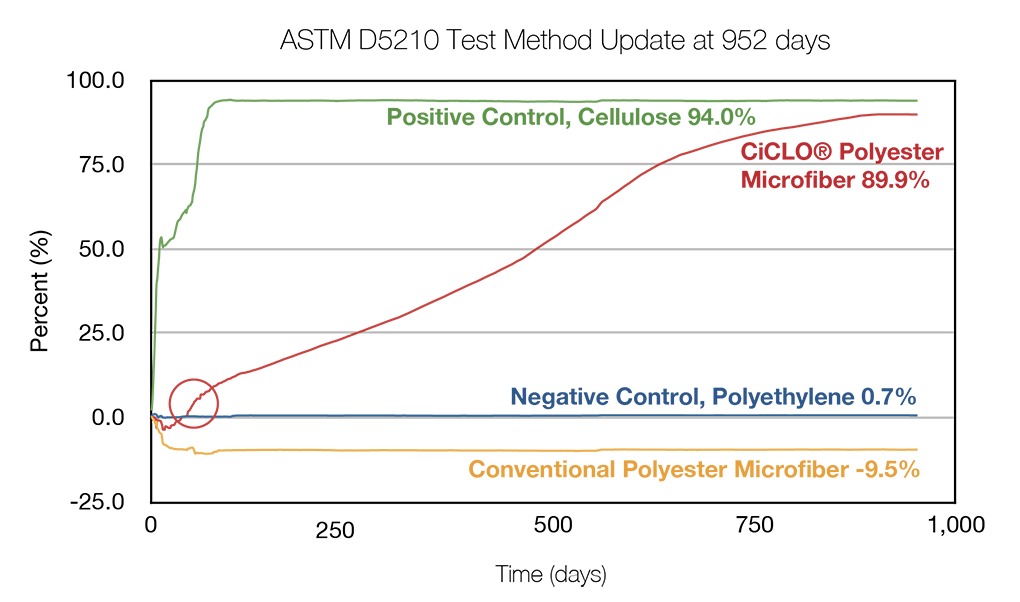CiCLO® fibers, yarns and textiles have been proven effective over the course of several years through reliable scientific data gathered from third party laboratory studies that determine the rate and extent of biodegradation in simulated environments, including wastewater treatment plant sludge, seawater, soil and landfill.
The American Society for Testing and Materials (ASTM) has established internationally recognized scientific and technological tests to measure true biodegradation of plastic products in these environments. Long term studies demonstrate clearly how CiCLO® textiles and fugitive microfibers are metabolized by microbes while untreated textiles remain persistent and refractory in those same environments.
Natural Seawater Environment
ASTM D6691-17 Standard Test Method for Determining Aerobic Biodegradation of Plastic Materials in the Marine Environment by a Defined Microbial Consortium or Natural Sea Water Inoculum
This test method determines the rate and degree of aerobic biodegradation of plastic materials exposed to the indigenous population existing in natural seawater.
After 1,362 days in natural sea water, CiCLO® fibers (red line) biodegraded 94.34%, whereas comparable untreated fibers (yellow line) biodegraded 4.97%.
Soil
ASTM D5988 Standard Test Method for Determining Aerobic Biodegradation of Plastic Materials in Soil
This test method determines the degree and rate of aerobic biodegradation of synthetic plastic materials on exposure to fertile soil to assure active microbiota that is mixed with compost to simulate agricultural applications. Research shows that agricultural lands receive large amounts of microfibers via biosolids application.
After 1,171 days in soil conditions, CiCLO® microfibers (green line) are biodegraded 91.1%, whereas comparable untreated microfibers (blue line) have not biodegraded at all.
Anaerobic Digester Conditions (Biologically Active Landfill)
ASTM D5511-18 Standard Test Method for Determining Anaerobic Biodegradation of Plastic Materials Under High-Solids Anaerobic-Digestion Conditions
This test method determines the rate and degree of anaerobic biodegradability of plastic products when placed in a high-solids anaerobic digester for the production of digestate from municipal solid waste (simulated landfill conditions).
After 1,278 days in anaerobic landfill conditions, CiCLO® fabric (purple line) biodegraded 91.1%, whereas comparable untreated fabric (yellow line) only reached 6.2% biodegradation. Upon inspection, the CiCLO® fabric was fully biodegraded. Although the graph reads 91.1%, the remaining percent can be attributed to carbon being incorporated into biomass.

Wastewater Treatment Plant Sludge
ASTM D5210-92(2007) Standard Test Method for Determining the Anaerobic Biodegradation of Plastic Materials in the Presence of Municipal Sewage Sludge
This test method determines the degree and rate of anaerobic biodegradation of synthetic plastic materials on exposure to anaerobic-digester municipal sewage sludge from a wastewater plant.
Research shows that wastewater treatment plants may remove 65-99% of the synthetic microfibers that enter the plant through washing machine effluent, the majority of which are retained in the sewage sludge that undergoes digestion in an anaerobic digester for an average of 15-60 days.1
After 952 days in wastewater treatment plant sludge, CiCLO® microfibers (red line) are biodegraded 89.9%, whereas comparable untreated microfibers (yellow line) have not biodegraded at all. Note that after 55 days, because as mentioned, the typical gestation time at the plant is only up to 60 days CiCLO® microfibers reached 14.9% (circled).
- Source: Bren Microplastics